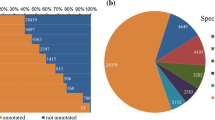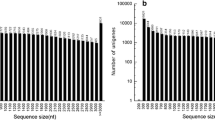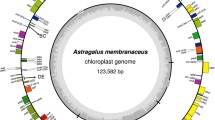Abstract
Pongamia pinnata (also called Millettia pinnata), a non-edible oil yielding tree, is well known for its multipurpose benefits and acts as a potential source for medicine and biodiesel preparation. Due to increase in demand for cultivation, understanding of genetic diversity is an important parameter for further breeding and cultivation programme. Transposable elements (TEs) are a major component of plant genome but still, their evolutionary significance in Pongamia remains unexplored. In view to understand the role of TEs in genome diversity, Pongamia unigenes were screened for the presence of TE cassettes. Our analysis showed the presence of all categories of TE cassettes in unigenes with major contribution of long terminal repeat-retrotransposons towards unigene diversity. Interestingly, the insertion of some TEs was also observed in both organellar genomes. The study of insertion of TEs in coding sequence is of great interest as they may be responsible for protein diversity thereby influencing the phenotype. The present investigation confirms the exaptation phenomenon in pyruvate decarboxylase (PDC) gene where the entire exon sequence was derived from Ty3-gypsy like retrotransposon. The study of PDC protein revealed the translation of gypsy element into protein. Furthermore, the phylogenetic study confirmed the diversity in PDC gene due to insertion of the gypsy element, where the PDC genes with and without gypsy insertion were clustered separately.




Similar content being viewed by others
References
McClintock, B. (1950). The origin and behavior of mutable loci in maize. Proceedings of the National Academy of Sciences of the USA,6, 344–355.
Baucom, R. S., Estill, J. C., Leebens-Mack, J., & Bennetzen, J. L. (2009). Natural selection on gene function drives the evolution of LTR retrotransposon families in the rice genome. Genome Research,2, 243–254.
Kanazawa, A., Liu, B., Kong, F., Arase, S., & Abe, J. (2009). Adaptive evolution involving gene duplication and insertion of a novel Ty1/copia-like retrotransposon in soybean. Journal of Molecular Evolution,69, 164–175.
O’Donnell, K. A., & Burns, K. H. (2010). Mobilizing diversity: Transposable element insertions in genetic variation and disease. Mobile DNA,1, 21.
Chuong, E. B., Elde, N. C., & Feschotte, C. (2017). Regulatory activities of transposable elements: From conflicts to benefits. Nature Reviews Genetics,18, 71–86.
Almeida, L. M., Silva, I. T., Silva, W. A., Jr., Castro, J. P., Riggs, P. K., Carareto, C. M., et al. (2007). The contribution of transposable elements to Bos taurus gene structure. Gene,390, 180–189.
Sakai, H., Tanaka, T., & Itoh, T. (2007). Birth and death of genes promoted by transposable elements in Oryza sativa. Gene,392, 59–63.
Brosius, J., & Gould, S. J. (1992). On “genomenclature”: A comprehensive (and respectful) taxonomy for pseudogenes and other “junk DNA”. Proceedings of the National academy of Sciences of the United States of America,89, 10706.
Lopes, F. R., Carazzolle, M. F., Pereira, G. A., Colombo, C. A., & Carareto, C. M. (2008). Transposable elements in Coffea (Gentianales: Rubiacea) transcripts and their role in the origin of protein diversity in flowering plants. Molecular Genetics and Genomics,279, 385–401.
Kawase, M., Fukunaga, K., & Kato, K. (2005). Diverse origins of waxy foxtail millet crops in East and Southeast Asia mediated by multiple transposable element insertions. Molecular Genetics and Genomics,274, 131–140.
Magalhaes, J. V., Liu, J., Guimaraes, C. T., Lana, U. G., et al. (2007). A gene in the multidrug and toxic compound extrusion (MATE) family confers aluminum tolerance in Sorghum. Nature Genetics,39, 1156–1161.
Hisano, H., Tsujimura, M., Yoshida, H., Terachi, T., & Sato, K. (2016). Mitochondrial genome sequences from wild and cultivated barley (Hordeum vulgare). BMC Genomics,17, 824.
Shelke, R. G., & Rangan, L. (2019). Isolation and characterisation of Ty1-copia retrotransposons from Pongamia pinnata. Trees—Structure and Function. https://doi.org/10.1007/s0046.
Kesari, V., Madurai Sathyanarayana, V., Parida, A., & Rangan, L. (2010). Molecular marker-based characterization in candidate plus trees of Pongamia pinnata, a potential biodiesel legume. AoB Plants. https://doi.org/10.1093/aobpla/plq017.
Huang, J., Lu, X., Yan, H., Chen, S., Zhang, W., Huang, R., et al. (2012). Transcriptome characterization and sequencing-based identification of salt-responsive genes in Millettia pinnata, a semi-mangrove plant. DNA Research,19, 195–207.
Huang, J., Guo, X., Hao, X., Zhang, W., Chen, S., Huang, R., et al. (2016). De novo sequencing and characterization of seed transcriptome of the tree legume Millettia pinnata for gene discovery and SSR marker development. Molecular Breeding,36, 75.
Kazakoff, S. H., Imelfort, M., Edwards, D., Koehorst, J., Biswas, B., Batley, J., et al. (2012). Capturing the biofuel wellhead and powerhouse: The chloroplast and mitochondrial genomes of the leguminous feedstock tree Pongamia pinnata. PLoS ONE,7, e51687.
Pohlman, R. F., Fedoroff, N. V., & Messing, J. (1984). The nucleotide sequence of the maize controlling element Activator. Cell,37, 635–643.
Schnable, P. S., Ware, D., Thane, T., et al. (2009). The B73 maize genome: Complexity, diversity, and dynamics. Science,326, 1112–1115.
Ganko, E. W., Bhattacharjee, V., Schliekelman, P., & Mcdonald, J. F. (2003). Evidence for the contribution of LTR retrotransposon to C. elegans gene evolution. Molecular Biolology and Evolution,20, 1925–1931.
Debarry, J. D., Ganko, E. W., Mccarthy, E. M., & Mcdonald, J. F. (2006). The contribution of LTR retrotransposon sequences to gene evolution in Mus musculus. Molecular Biology and Evolution,23, 479–481.
Ma, J., Devos, K. M., & Bennetzen, J. L. (2004). Analyses of LTR-retrotransposon structures reveal recent and rapid genomic DNA loss in rice. Genome Research,14, 860–869.
Lopes, F. R., Jjingo, D., Da Silva, C. R., Andrade, A. C., Marraccini, P., Teixeira, J. B., et al. (2013). Transcriptional activity, chromosomal distribution and expression effects of transposable elements in Coffea genomes. PLoS ONE,8, e78931.
Van De Lagemaat, L. N., Landry, J. R., Mager, D. L., & Medstrand, P. (2003). Transposable elements in mammals promote regulatory variation and diversification of genes with specialized functions. Trends Genetics,19, 530–536.
Lorenc, A., & Makalowski, W. (2003). Transposable elements and vertebrate protein diversity. Genetica,118, 183–189.
Orgel, L. E., & Crick, F. H. (1980). Selfesh DNA: The ultimate parasite. Nature,284, 604–607.
Nekrutenko, A., & Li, W. H. S. (2001). Transposable elements are found in a large number of human protein-coding genes. Trends in Genetics,17, 619–621.
Makałowski, W., Kischka, T., & Makałowska, I. (2017). Contribution of transposable elements to human proteins. eLS. https://doi.org/10.1002/9780470015902.a0020793.pub2.
Nuzhdin, S. V. (1999). Sure facts, speculations, and open questions about the evolution of transposable element copy number. Genetica,107, 129–137.
Gotea, V., & Makalowski, W. (2006). Do transposable elements really contribute to proteomes? Trends in Genetics,22, 260–267.
Hossain, M. A., Huq, E., Grover, A., Dennis, E. S., Peacock, W. J., & Hodges, T. K. (1996). Characterization of pyruvate decarboxylase genes from rice. Plant Molecular Biology,31, 761–770.
Talarico, L. A., Ingram, L. O., & Maupin-Furlow, J. A. (2001). Production of the gram-positive Sarcina ventriculi pyruvate decarboxylase in Escherichia coli. Microbiology,147, 2425–2435.
Ohno, S. (1970). Evolution by gene duplication. London: George Alien & Unwin Ltd.
Robins, D. M., & Samuelson, L. C. (1992). Retrotransposons and the evolution of mammalian gene expression. Genetica,86, 191–201.
Kursteiner, O., Dupuis, I., & Kuhlemeier, C. (2003). The pyruvate decarboxylase1 gene of Arabidopsis is required during anoxia but not other environmental stresses. Plant Physiology,132, 968–978.
Mithran, M., Paparelli, E., Novi, G., Perata, P., & Loreti, E. (2014). Analysis of the role of the pyruvate decarboxylase gene family in Arabidopsis thaliana under low-oxygen conditions. Plant Biology,16, 28–34.
Cavrak, V. V., Lettner, N., Jamge, S., Kosarewicz, A., Bayer, L. M., & Scheid, O. M. (2014). How a retrotransposon exploits the plant’s heat stress response for its activation. PLoS Genetics,10, e1004115.
Ito, H., Kim, J. M., Matsunaga, W., Saze, H., Matsui, A., Endo, T., et al. (2016). A stress-activated transposon in Arabidopsis induces transgenerational abscisic acid insensitivity. Scientific Reports,6, 23181.
Negi, P., Rai, A. N., & Suprasanna, P. (2016). Moving through the stressed genome: Emerging regulatory roles for transposons in plant stress response. Frontiers in Plant Science,7, 1448.
Acknowledgements
We thank MHRD and IIT Guwahati, India for providing fellowship and computational facilities.
Author information
Authors and Affiliations
Corresponding author
Ethics declarations
Conflict of interest
None of the authors have any conflict of interest to declare.
Additional information
Publisher's Note
Springer Nature remains neutral with regard to jurisdictional claims in published maps and institutional affiliations.
Electronic supplementary material
Below is the link to the electronic supplementary material.
Rights and permissions
About this article
Cite this article
Shelke, R.G., Rangan, L. The Role of Transposable Elements in Pongamia Unigenes and Protein Diversity. Mol Biotechnol 62, 31–42 (2020). https://doi.org/10.1007/s12033-019-00223-0
Published:
Issue Date:
DOI: https://doi.org/10.1007/s12033-019-00223-0




